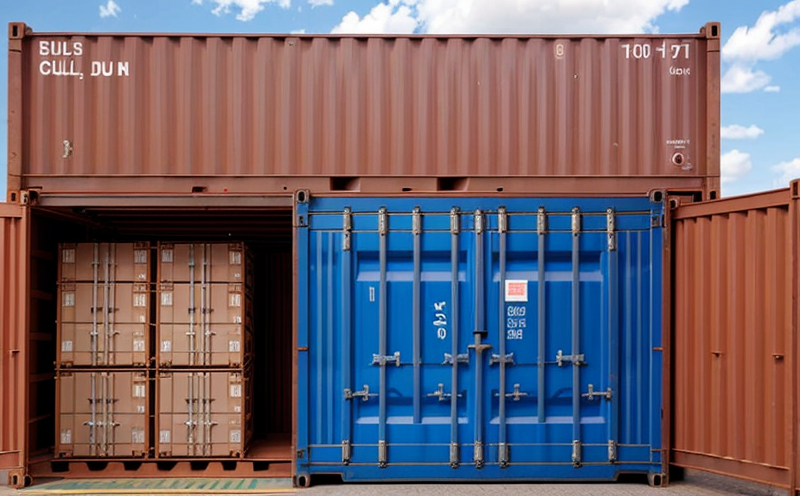USP Hydrogen Peroxide Vapor Sterilization Packaging Testing
The USP Hydrogen Peroxide Vapor Sterilization Packaging Testing is a crucial process in ensuring that pharmaceutical packaging and container closure systems meet the stringent requirements set forth by the U.S. Pharmacopeia (USP). This testing is vital for maintaining product integrity, safety, and efficacy during sterilization processes.
The USP guidelines outline specific standards for the use of hydrogen peroxide vapor as a sterilant in pharmaceutical environments. Hydrogen peroxide vapor is known for its potent antimicrobial properties, which make it an effective sterilizing agent. However, its corrosive nature necessitates careful handling and testing to ensure that packaging materials do not degrade or release harmful substances into the final product.
The testing process typically involves placing a sample of the packaging material in a chamber where hydrogen peroxide vapor is introduced at controlled levels. The sample remains in the chamber for a specified duration, simulating real-world sterilization conditions. Afterward, the sample undergoes rigorous evaluation to assess its integrity and functionality post-sterilization.
One key aspect of this testing is the ability to predict long-term performance. Packaging materials must not only withstand immediate exposure to hydrogen peroxide vapor but also maintain their structural integrity over time. This requires a comprehensive understanding of material properties, including thermal stability, chemical resistance, and mechanical strength. The testing process aims to identify any potential weaknesses or degradation that could compromise product safety.
Another critical element is the assessment of compatibility between the packaging materials and the hydrogen peroxide vapor itself. Certain polymers and adhesives can react with hydrogen peroxide in ways that may lead to off-gassing, discoloration, or physical changes. These reactions must be carefully monitored to ensure they do not affect product quality or introduce contaminants into the final package.
Accurate and reliable testing is essential for pharmaceutical companies to comply with regulatory requirements and maintain a high standard of quality control. By adhering to USP standards, manufacturers can trust that their packaging materials will perform consistently across various sterilization cycles, thereby protecting both product integrity and patient safety.
The importance of this testing cannot be overstated, especially given the increasing complexity of pharmaceutical products and the need for advanced sterilization methods. Hydrogen peroxide vapor is a preferred choice in many applications due to its effectiveness, but it demands meticulous attention to detail during packaging design and manufacturing processes.
In summary, USP Hydrogen Peroxide Vapor Sterilization Packaging Testing ensures that pharmaceutical packaging meets stringent standards of quality and safety. By adhering to these rigorous testing protocols, manufacturers can confidently produce sterile products that maintain their integrity throughout the sterilization process and beyond.
Scope and Methodology
The scope of USP Hydrogen Peroxide Vapor Sterilization Packaging Testing encompasses a range of materials used in pharmaceutical packaging. This includes various types of plastics, metals, and adhesives that come into contact with the hydrogen peroxide vapor during sterilization. The testing process is designed to evaluate the compatibility and integrity of these materials under controlled conditions.
The methodology for this testing involves placing a sample of the packaging material in a specially designed chamber where hydrogen peroxide vapor is introduced at specific concentrations and temperatures. The sample remains in the chamber for a predetermined period, allowing sufficient time for sterilization to occur. Post-sterilization, the sample undergoes detailed analysis to assess its physical properties and chemical composition.
Key parameters measured during this testing include:
- Physical integrity of the packaging material
- Chemical compatibility with hydrogen peroxide vapor
- Mechanical strength and flexibility of the sample
- Presence of any off-gassing or degradation products
The testing process is conducted in accordance with USP guidelines, which specify the exact conditions under which the samples should be exposed to hydrogen peroxide vapor. Compliance with these standards ensures that the results are reliable and can be trusted by regulatory bodies and industry professionals.
By following this rigorous methodology, laboratories can provide manufacturers with comprehensive data on the performance of their packaging materials under hydrogen peroxide sterilization conditions. This information is invaluable for ensuring product safety and efficacy in compliance with regulatory requirements.
Quality and Reliability Assurance
Ensuring quality and reliability in pharmaceutical testing requires a robust framework that encompasses multiple stages, from sample preparation to final analysis. At our laboratory, we have established stringent protocols and procedures to guarantee the accuracy and consistency of our USP Hydrogen Peroxide Vapor Sterilization Packaging Testing.
The first step in this process is meticulous sample preparation. This involves selecting representative samples from different batches or production runs to ensure that the test results are reflective of broader product characteristics. Once selected, these samples undergo thorough cleaning and conditioning to remove any contaminants that could affect the testing outcome.
During the actual sterilization process, we employ advanced equipment capable of controlling temperature, humidity, and hydrogen peroxide vapor concentration within precise tolerances. This ensures that each sample is exposed to consistent conditions throughout the test duration. Our facilities are equipped with state-of-the-art monitoring systems that continuously track key parameters, allowing for real-time adjustments if necessary.
Post-sterilization evaluation involves a series of tests designed to assess various aspects of the packaging material's performance. These include visual inspections for any visible damage or changes in appearance; mechanical testing to measure strength and flexibility; chemical analysis to detect off-gassing compounds; and microbiological testing to verify sterility.
Our laboratory personnel are highly trained experts who adhere strictly to USP standards during every stage of the testing process. They possess deep knowledge of material science, sterilization techniques, and quality assurance practices, enabling them to provide accurate and reliable results. Regular calibration and validation of our equipment ensure that all measurements remain within acceptable limits.
By implementing these rigorous quality control measures, we can confidently deliver comprehensive reports that meet the highest standards of pharmaceutical testing. Our commitment to excellence ensures that manufacturers receive dependable data on their packaging materials' performance under hydrogen peroxide vapor sterilization conditions.





